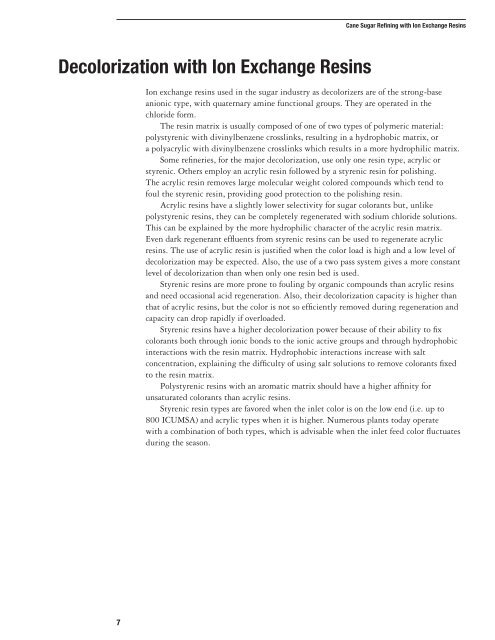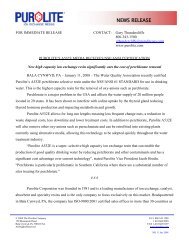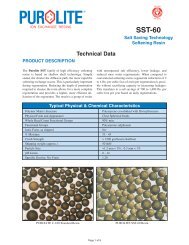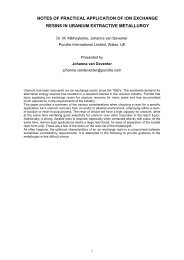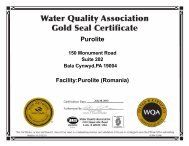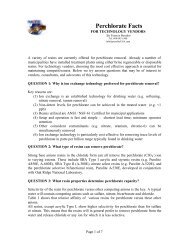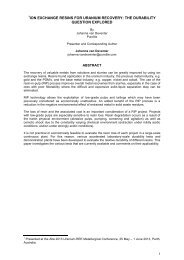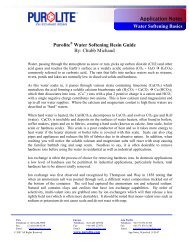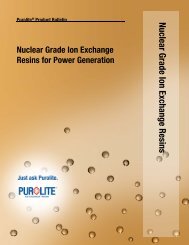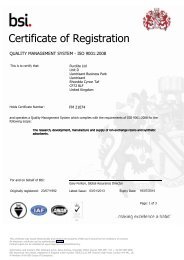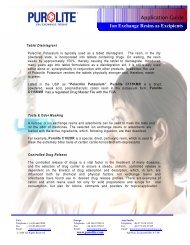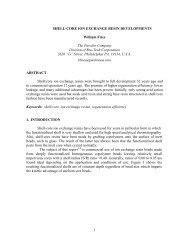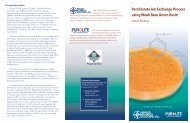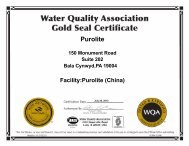Cane Sugar Refining - Purolite
Cane Sugar Refining - Purolite
Cane Sugar Refining - Purolite
Create successful ePaper yourself
Turn your PDF publications into a flip-book with our unique Google optimized e-Paper software.
Decolorization with Ion Exchange Resins<br />
7<br />
<strong>Cane</strong> <strong>Sugar</strong> <strong>Refining</strong> with Ion Exchange Resins<br />
Ion exchange resins used in the sugar industry as decolorizers are of the strong-base<br />
anionic type, with quaternary amine functional groups. They are operated in the<br />
chloride form.<br />
The resin matrix is usually composed of one of two types of polymeric material:<br />
polystyrenic with divinylbenzene crosslinks, resulting in a hydrophobic matrix, or<br />
a polyacrylic with divinylbenzene crosslinks which results in a more hydrophilic matrix.<br />
Some refineries, for the major decolorization, use only one resin type, acrylic or<br />
styrenic. Others employ an acrylic resin followed by a styrenic resin for polishing.<br />
The acrylic resin removes large molecular weight colored compounds which tend to<br />
foul the styrenic resin, providing good protection to the polishing resin.<br />
Acrylic resins have a slightly lower selectivity for sugar colorants but, unlike<br />
polystyrenic resins, they can be completely regenerated with sodium chloride solutions.<br />
This can be explained by the more hydrophilic character of the acrylic resin matrix.<br />
Even dark regenerant effluents from styrenic resins can be used to regenerate acrylic<br />
resins. The use of acrylic resin is justified when the color load is high and a low level of<br />
decolorization may be expected. Also, the use of a two pass system gives a more constant<br />
level of decolorization than when only one resin bed is used.<br />
Styrenic resins are more prone to fouling by organic compounds than acrylic resins<br />
and need occasional acid regeneration. Also, their decolorization capacity is higher than<br />
that of acrylic resins, but the color is not so efficiently removed during regeneration and<br />
capacity can drop rapidly if overloaded.<br />
Styrenic resins have a higher decolorization power because of their ability to fix<br />
colorants both through ionic bonds to the ionic active groups and through hydrophobic<br />
interactions with the resin matrix. Hydrophobic interactions increase with salt<br />
concentration, explaining the difficulty of using salt solutions to remove colorants fixed<br />
to the resin matrix.<br />
Polystyrenic resins with an aromatic matrix should have a higher affinity for<br />
unsaturated colorants than acrylic resins.<br />
Styrenic resin types are favored when the inlet color is on the low end (i.e. up to<br />
800 ICUMSA) and acrylic types when it is higher. Numerous plants today operate<br />
with a combination of both types, which is advisable when the inlet feed color fluctuates<br />
during the season.


